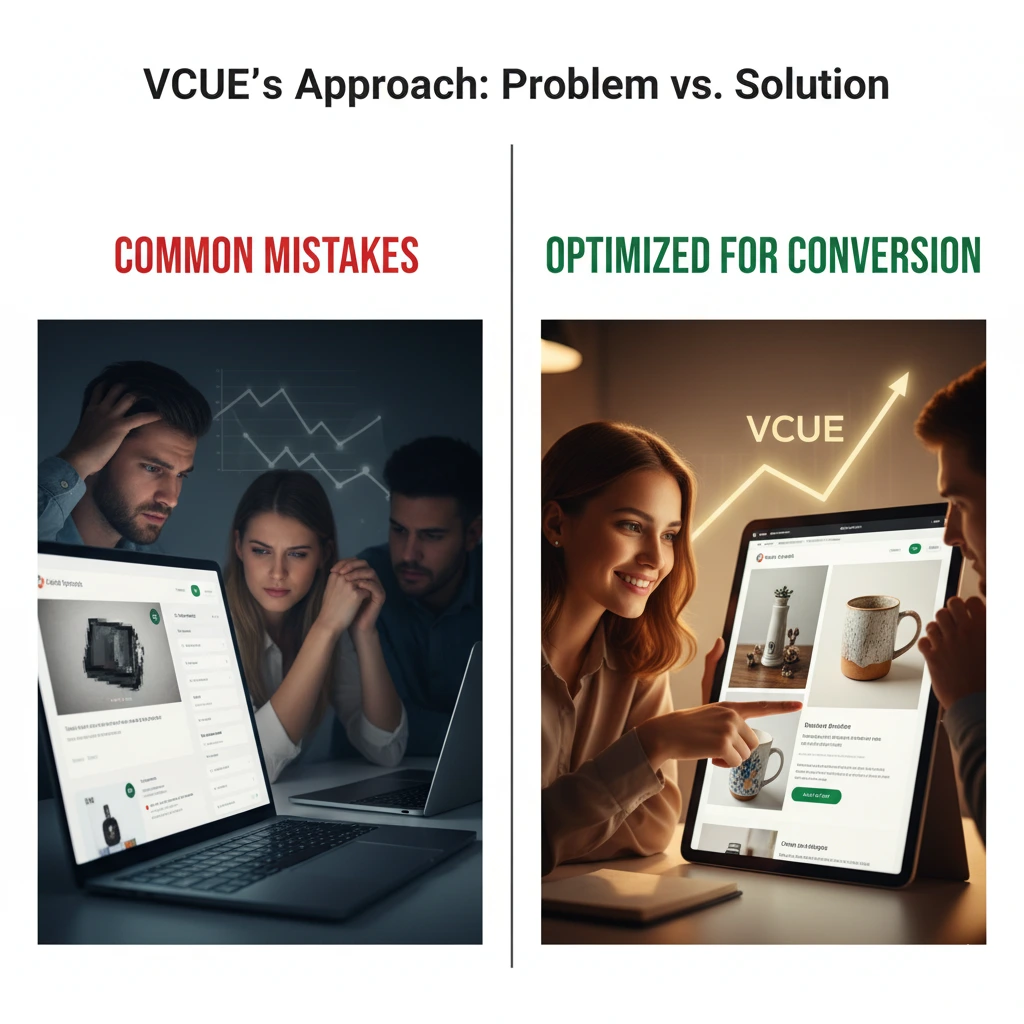In today’s competitive online marketplace, attracting visitors to your e-commerce store is only half the battle. Turning those visitors into paying customers is the real challenge. Many e-commerce brands struggle with low conversion rates due to common mistakes that drive potential buyers away. By understanding these pitfalls and learning how VCUE, a leading e-commerce platform, avoids them, brands can significantly boost sales and grow sustainably.
Mistake 1: Poor Website Navigation
Why It Hurts Conversions
Confusing menus, cluttered layouts, and unclear navigation paths frustrate users. If visitors can’t find what they need quickly, they leave, often never to return.
How VCUE Solves It
VCUE prioritizes intuitive navigation with well-organized categories, search functions, and filters. Visitors can effortlessly browse products, compare options, and move through the checkout process, resulting in higher conversions and improved user satisfaction.
Mistake 2: Low-Quality Product Images and Descriptions
Why It Hurts Conversions
Online shoppers rely heavily on visuals and detailed product information. Poor-quality images, lack of multiple views, or vague descriptions create uncertainty, which kills purchase confidence.
How VCUE Solves It
VCUE emphasizes high-resolution images, 360-degree product views, and comprehensive descriptions. Interactive media, like videos and zoomable images, allows customers to examine products closely, reducing hesitation and building trust.
Mistake 3: Complicated Checkout Process
Why It Hurts Conversions
Long forms, mandatory account creation, and unexpected costs at checkout lead to abandoned carts. Even small friction points can significantly lower conversion rates.
How VCUE Solves It
VCUE provides a streamlined, user-friendly checkout with guest checkout options, multiple payment methods, and transparent pricing. By minimizing steps and reducing friction, the platform helps brands recover potential sales and retain customers.
Mistake 4: Ignoring Mobile Optimization
Why It Hurts Conversions
With a growing number of users shopping on smartphones, sites that aren’t mobile-friendly lose a huge share of potential sales. Slow load times, small text, and unresponsive design frustrate mobile shoppers.
How VCUE Solves It
VCUE is built for mobile-first experiences, ensuring fast loading, responsive design, and touch-friendly navigation. Brands using VCUE can reach mobile shoppers effectively, turning visits into conversions across devices.
Mistake 5: Lack of Personalized Experiences
Why It Hurts Conversions
Generic product recommendations, irrelevant promotions, and no targeted engagement make customers feel like just another number. Without personalization, brands struggle to create meaningful connections and repeat purchases.
How VCUE Solves It
VCUE leverages AI-driven personalization, offering tailored product recommendations, personalized emails, and dynamic content based on user behavior. This emotional and contextual connection increases engagement, boosts conversions, and encourages loyalty.
Why Avoiding These Mistakes Matters
- Higher Conversion Rates: Eliminating barriers directly increases sales.
- Better Customer Experience: Smooth, enjoyable shopping keeps users coming back.
- Stronger Brand Loyalty: Customers trust brands that provide clarity, quality, and personalized attention.
- Increased Revenue: Optimized user experiences reduce cart abandonment and maximize ROI.
Conclusion
Many e-commerce brands unknowingly sabotage their sales through common mistakes like poor navigation, low-quality visuals, complicated checkout, lack of mobile optimization, and impersonal experiences. VCUE stands out by proactively addressing these issues, offering a platform designed to enhance user experience, build trust, and maximize conversions.
For any brand looking to grow in the digital marketplace, understanding these pitfalls—and choosing a solution like VCUE—can make the difference between struggling with low sales and thriving in a competitive e-commerce landscape.




